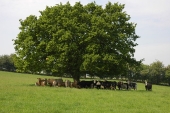Don't plant Hackberrys. They're not long-lived and not worth the hassle. By the time, they get big enough to provide a bit of shade, they're nearly dead and have the nasty habit of falling over and taking out other trees with them because the roots seem to die before the rest of the tree.
At least here in Texas, Hackberrys getting 30' tall or so. I think what you want is probably lower growing. Talk to your county agricultural office and see what's native in your area. You might even be able to create enough of an area to get some sort of wildlife exemption if done properly.
Lots of native shrubs/short trees like Hollys, Witch Hazel, Madrone, Hawthorne, Viburnums, Willows, Buddelia, Choke Cherry, Ninebark, etc. It just depends on what's native in your area. This is where the County Agri office can help you out. They can also help you, in a lot of cases, to source the plants as well since they'll either be familiar with local growers or be able to point you to something like the master gardener program where there will be people who do know the local growers.
If you need big shade trees quickly, look at cottonwoods, ashes, or locusts. If you're OK with thorns, I really recommend the locust trees. They're minimally trashy, The seed pods are a favorite of wildlife. The shade isn't dense enough to shade out other plants.
For fruit trees, a lot will depend on how well you can meet the chilling requirements of most of the trees. Apples, pears, plums, peaches, cherries, all grow here depending on the variety and location.
Nut trees - chestnut , hickory, pecan, fiberts(hazelnuts), black walnuts but for wild life that includes most oaks, sweetgums, pine and whole host of other trees that produce nuts.
Fruit vines are probably a safer bet - blackberry, various wild grapes. mayhaws, but even pricky pear cactus pears are edible (and delicious) if you have the fortitude to harvest them and burn the spines off.








